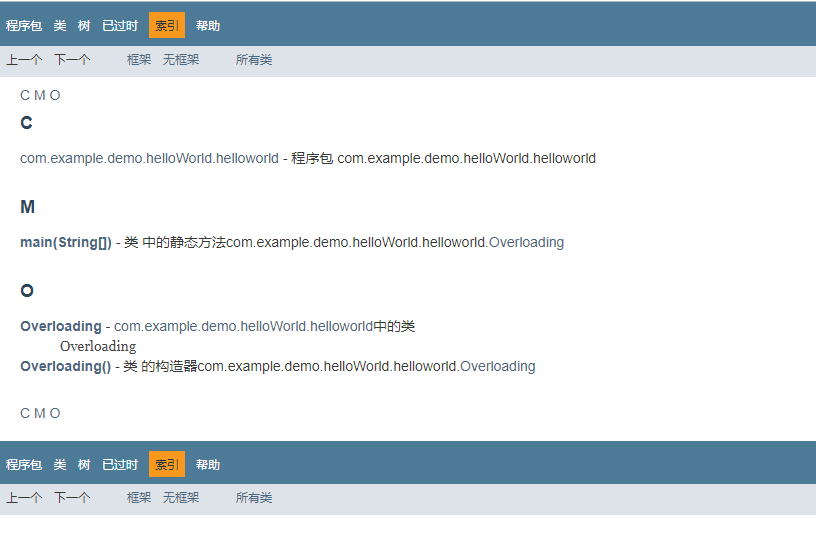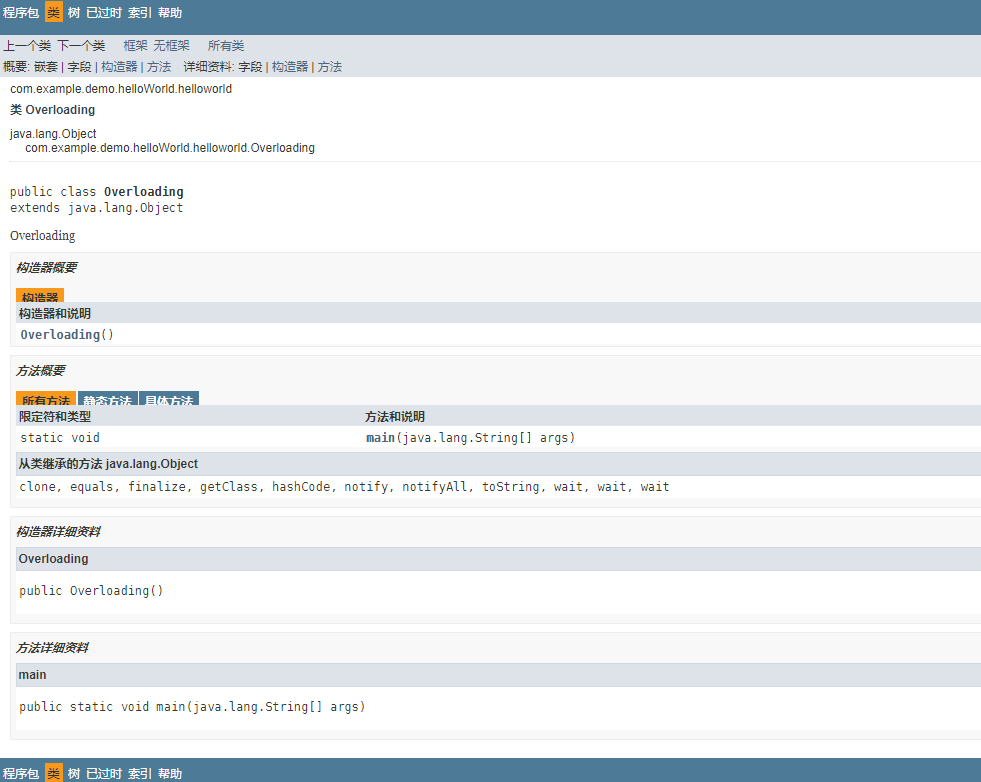一、 创建一个类,它包含一个int域和一个char域,它们都没有被初始化,将它们的值打印出来,以验证Java执行了默认初始化。
private static char c;
private static int i;
public static void main(String[] args){
System.out.println(String.valueOf(c));
System.out.println(String.valueOf(i));
}
返回值:
0
二、参照本章的HelloDate.java这个例子,创建一个“Hello,World”程序,该程序只要输出这句话即可。
书中HelloDate源码:
import java.util.*;
public class HelloDate {
public static void main(String[] args){
System.out.println("Hello, it's:");
System.out.println(new Date());
}
}
修改后HelloWorld源码:
public class HelloWorld {
public static void main(String[] args){
System.out.println("Hello, World");
}
}
返回值:Hello, World
三、找出含有ATypeName的代码段,将其改为完整的程序。
public class ATypeName {
/* Class body goes here */
private String id;
private String name;
public ATypeName() {
}
public ATypeName(String id, String name) {
this.id = id;
this.name = name;
}
@Override
public String toString() {
return "ATypeName{" +
"id='" + id + '\'' +
", name='" + name + '\'' +
'}';
}
}
public class Main{
public static void main(String[] args){
ATypeName a = new ATypeName(1,"张三");
System.out.println(a.toString());
}
}
返回:ATypeName{id='1', name='张三'}
四、将DataOnly代码段改写成一个程序。略。
五、修改前一个联系,将DataOnly中的数据改写成mian()方法中赋值并打印出来。参照(三)
六、编写一个程序,让它含有本章所定义的storage()方法的代码段,并调用之。
public class HelloWorld {
public static void main(String[] args) {
System.out.println(storage("HelloWorld"));
}
private static int storage(String s) {
return s.length() * 2;
}
}
返回:20
七、将Incrementtable的代码改写成一个完整的可运行程序。
public class StaticTest {
static int i = 47;
}
public class Incrementtable {
static void increment(){
StaticTest.i++;
}
}
public class HelloWorld {
public static void main(String[] args){
System.out.println("before StaticTest.i:" + StaticTest.i);
Incrementtable.increment();
System.out.println("after StaticTest.i:" + StaticTest.i);
}
}
返回:
before StaticTest.i:47
after StaticTest.i:48
八、编写一个程序,展示无论你创建了某个特定类的多少个对象,这个类中的某个特定的static域只有一个对象。
public class StaticTest {
static String s = new String("HelloWorld");
}
public class HelloWorld {
public static void main(String[] args) {
StaticTest st1 = new StaticTest();
StaticTest st2 = new StaticTest();
StaticTest st3 = new StaticTest();
StaticTest st4 = new StaticTest();
System.out.println("st1.s == st2.s : "+(st1.s == st2.s));
System.out.println("st1.s == st3.s : "+(st1.s == st3.s));
System.out.println("st1.s == st4.s : "+(st1.s == st4.s));
}
}
返回:
st1.s == st2.s : true
st1.s == st3.s : true
st1.s == st4.s : true
九、编写一个程序,展示自动包装功能对所有的基本类型和包装器类型都起作用。
public class HelloWorld {
public static void main(String[] args) {
int i1 = 127;
Integer ii1 = i1;
int i2 = ii1;
int i3 = 128;
Integer ii2 = i3;
int i4 = ii2;
}
}
十、编写一个程序,打印出从命令行获取的三个参数。为此,要确定命令行数组中String的下标。
public class HelloWorld {
public static void main(String[] args) {
Scanner s = new Scanner(System.in);
String s1 = s.next();
String s2 = s.next();
String s3 = s.next();
System.out.println(s1);
System.out.println(s2);
System.out.println(s3);
}
}
输入:
hello
world
!
返回:
hello
world
!
十一、将AllTheColorsOfTheRainbow这个示例改写成一个程序。
public class AllTheColorsOfTheRainbow {
int anIntegerRepresentingColors;
void changeTheHueOfTheColor(int newValue){
this.anIntegerRepresentingColors = newValue;
}
}
public class HelloWorld {
public static void main(String[] args) {
AllTheColorsOfTheRainbow a = new AllTheColorsOfTheRainbow();
a.changeTheHueOfTheColor(2);
System.out.println(a.anIntegerRepresentingColors);
}
}
返回:2
十二、找出HelloDate.java的第二版本,也就是那个简单注释文档的示例。对该文档执行javadoc,然后通过Web浏览器观看运行结果。
//:HelloDate.java
import java.util.Date;
/**
* The first Thinking in Java example program.
* Displays a string and today's date.
*
* @author Bruce Eckel
* @author www.MindView.net
* @version 4.0
*/
public class HelloDate {
/**
* Entrv Doint to class & application
*
* @param args array of string arguments
* @throws exceptions No exceptions thrown
*/
public static void main(String[] args) {
System.out.println("Hello, it's: ");
System.out.println(new Date());
}
}
/* Output: (55% match)
Hello, it's:
Wed Oct 05 14:39:36 MDT 2005
*///:~
页面:
十三、通过javadoc运行Documentation1.java、Documentation2.java、Documentation3.java,然后通过Web浏览器验证所产生的文档。
懒得弄了,盗图~

十四、在前一个练习的文档中加入各项的HTML列表
略
十五、使用练习2的程序,加入注释文档。用javadoc提取此注释文档,并产生一个HTML文件,然后通过Web浏览器查看结果。
//: HelloWorld.java
/**
* HelloWorld class
* @version 1.0
* @see String
* @author jojo
*/
public class HelloWorld {
/**
* HelloWorld method
* @param args
*/
public static void main(String[] args){
System.out.println("Hello, World");
}
}
//:~
页面:
十六、找到第5章中的Overloading.java示例,并为它加入javadoc文档。然后用javadoc提取此注释文档,并产生一个HTML文件,最后,通过Web浏览器查看结果。
//: Overloading.java
/**
* Tree class
* @author jojo
* @version 1.0
*/
class Tree {
/**
* height
*/
int height;
/**
* Planting a seedling
*/
Tree() {
System.out.println("Planting a seedling");
}
/**
* Creating new Tree that is 0 feet tall
* @param i
*/
Tree(int i) {
System.out.println("Creating new Tree that is " + i + " feet tall");
height = i;
}
/**
* Tree is 0 feet tall
*/
void info() {
System.out.println("Tree is " + height + " feet tall");
}
/**
* s : Tree is 0 feet tall
* @param s
*/
void info(String s) {
System.out.println(s + ": Tree is " + height + " feet tall");
}
}
/**
* Overloading
*/
public class Overloading {
public static void main(String[] args) {
for(int i = 0; i < 5; i++) {
Tree t = new Tree(i);
t.info();
t.info("overloaded method");
}
// Overloaded constructor:
new Tree();
}
}
//:~
页面1:

